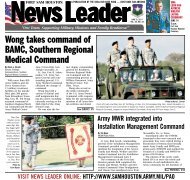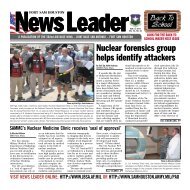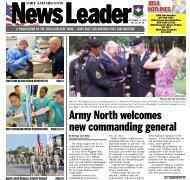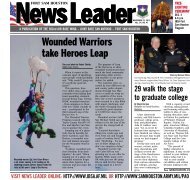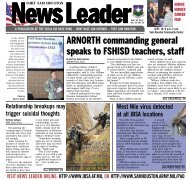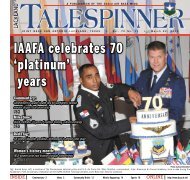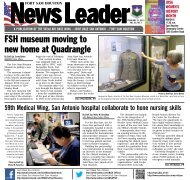Sept 20 - Joint Base San Antonio
Sept 20 - Joint Base San Antonio
Sept 20 - Joint Base San Antonio
- No tags were found...
Create successful ePaper yourself
Turn your PDF publications into a flip-book with our unique Google optimized e-Paper software.
PAGE 4WINGSPREADSEPTEMBER 27, <strong>20</strong>13Know what to do in case of an active shooter incidentBy Richard Coon902nd Security Forces Squadron<strong>Joint</strong> <strong>Base</strong> <strong>San</strong> <strong>Antonio</strong>-RandolphAbout 237 active shooterincidents occurred in the UnitedStates between 1966 and <strong>20</strong>10.Closer to home, as many areaware, we successfully reacted,responded and recoveredfrom an active shooter eventthat occured at <strong>Joint</strong> <strong>Base</strong><strong>San</strong> <strong>Antonio</strong>-Fort Sam HoustonJune 10.The recent active shooterincident at the WashingtonNavy Yard is a good reminderwe need to be prepared toreact if it happens at <strong>Joint</strong> <strong>Base</strong><strong>San</strong> <strong>Antonio</strong>.JBSA has established guidelinesand procedures to helpsave lives and maintain orderin the wake of these kinds ofevents.An active shooter is anyperson who is engaged in killingor attempting to kill people ina confined or populatedarea. In most cases, armedactive shooters show nopattern or method in theirselection of victims.This is often an unpredictable,rapidly evolvingsituation that demands animmediate response fromsecurity forces in order toterminate the life-threateningsituation.The first patrolmen to arriveon scene must locate theshooter or shooters and takeaggressive action to help protectlives. Rescue efforts will bedelayed until the danger can bemitigated or eliminated.Because active shooter situationsoften are ended within 10to 15 minutes, before law enforcementarrives on the scene,individuals must be prepared,mentally and physically, to dealwith an active shooter situationand follow directions.JBSA will declare an immediatelockdown during an activeshooter incident.Giant Voice and other availableforms of communicationwill be used to notify the basepopulace when an active shooteror similar threat is imminentand a lockdown is in effect.Hearing this term from crediblesources should solicit baseJOINT BASE SAN ANTONIO ACTIVE SHOOTER PROCESSIMMEDIATE DANGER (SEE)If you find yourself in immediate danger during a shooting incident within your work center,ESCAPE/EVACUATE from the scene, HIDE or as a last resort, TAKE ACTION.ESCAPE/EVACUATE: Plan your route, leave your stuff behind and exit with your hands visible.Security Forces personnel may mistake you for the shooter.HIDE: If you HIDE, contact Security Forces as soon as possible and safe to do so.TAKE ACTION: If you find yourself in IMMINENT DANGER, take action as a last resort. Attempt toincapacitate or act with physical aggression and throw items at the active shooter.RISK OF DANGER (HEAR)If you find yourself in risk of danger, such as you hear shooting, but are not being immediatelythreatened.LOCKDOWN: Secure yourself and your location. Once secured, position yourself in a place clearof direct fire. You should be able to observe the “way in” and “way out” routes. This will includethe process of facility lockdown and mitigating the room vulnerabilities. Mitigation will startwith locking the doors and windows and barricading access with anything available. Turn offIMMEDIATE DANGER (see)Escape/Evacuate• Move to nearest exit• Help others• Leave personal belongingsHide• Assess situation/location• What can protect you (stop bullets)• Look for way in/way out routes• Leaders TAKE CHARGE• Take action only as a last resortRISK OF DANGER (hear)Lockdown• Lock and barricade doors; turn off lights• Remain quiet and limit movementNotify• Your location (building/floor/room number)• Number of shooters and location(s)• Shooter description/weapon typeBASE NOTIFICATIONLockdownAccount• Be prepared to report status• Account for all personnelSHOOTING INCIDENT THREAT AIDStay Put• Stay put until proper notification• Cooperate with response forces• Leaders TAKE CHARGEINFORMATIONProvide to Security Forces:• Your Location• Number of shooters• Shooter(s) location• Description of the shooter• Type of weapons involved• Shooters direction of movementthe lights and make your location appear unoccupied.Monitor communications i.e. phone, computer, radio.NOTIFY AUTHORITIES: Call Security Forces. If a phone is withinyour secure location, dial your local emergency number and provideas much information as possible. Law Enforcement officials will ask directquestions to include locations, number of shooters, weapons involved,and descriptions.STAY PUT: Until the authorities instruct you to move or you have been released,DO NOT MOVE. Persons milling about increases confusion and the likelihood of injury.BASE NOTIFICATIONLockdown takes precedence over all other security related actions to include the administrativefunction of Force Protection Condition changes.Once the hostile situation is resolved and lockdown is terminated, all other securityrelatedactions should resume to include any Force Protection Condition changes.Only security forces move during lockdown.members to position themselvesin a secured place, clear ofdirect fire, where they can observeall entrances and exits.Those in lockdown shouldmitigate the location’s vulnerabilitiesby locking doors andwindows, and barricading accesswith anything available.Turn off the lights and makethe location appear unoccupied.Monitor communications – telephone,computer, radio.If a phone is within the securedlocation, members shouldcall security forces or 911.Callers will be asked to provideas much information as possibleto include location, weaponsinvolved and the number ofshooters and their descriptions.While in lockdown, membersare urged not to move untilauthorities instruct otherwise.For more information onactive shooter response procedures,contact security forces orvisit the 502nd Air <strong>Base</strong> Wingwebsite at http://www.502abw.af.mil to download an informationaltrifold.For immediate assistance atJBSA-Randolph, call Tech. Sgt.Taylor Rogal at 652-2744; atJBSA-Lackland, call Master Sgt.Jeremiah White at 671-2183;and at JBSA-Fort Sam Houston,call Officer Steve Kampman at221-2354.To download a copy ofthe <strong>Joint</strong> <strong>Base</strong> <strong>San</strong> <strong>Antonio</strong>Active Shooter Process, click onhttp://1.usa.gov/1h51S06.EMERGENCY DIAL 911Security ForcesJBSA-Fort Sam Houston/Camp Bullis221-2222JBSA-Lackland671-<strong>20</strong>18JBSA-Randolph652-5700File photosACTIVE SHOOTER RESOLUTIONALL CLEAR: Lockdown ends when installationcommand authority declares theincident over and the situation safe. Thisorder may be transmitted through localcommand or notification systems.WHEN HELP ARRIVESOnce Security Forces arrive:• Remain calm and follow instructions• Put down any items in your hands (i.e., bags, jackets)• Raise hands and spread fingers• Keep hands visible at all times• Avoid quick movements toward officers such as holdingon to them for safety• Avoid pointing, screaming or yelling• Do not stop to ask response forces for help or directionwhen evacuating
SEPTEMBER 27, <strong>20</strong>13 WINGSPREADPAGE 5Suicide victim’s mother calls for improved mental health educationBy Robert Goetz<strong>Joint</strong> <strong>Base</strong> <strong>San</strong> <strong>Antonio</strong>-Randolph Public AffairsThe mother of an Army sergeant who diedby suicide two years ago – a victim of mentalanguish caused by a traumatic brain injury suffered incombat in Iraq – brought her daughter’s story to <strong>Joint</strong><strong>Base</strong> <strong>San</strong> <strong>Antonio</strong>-Randolph last week.Margy Agar, the mother of Sgt. Kimberly Agar,a 25-year-old Soldier who died Oct. 3, <strong>20</strong>11, emphasizedthe need for better assessment of battlegroundinjuries and called for improved educationand communication regarding mental health issuesduring a symposium <strong>Sept</strong>. 19 at the JBSA-RandolphChapel Annex, one of the events of Suicide Awarenessand Prevention Month.“I’m here for two reasons – one, to honor herbecause it is well-deserved, and two, by becomingher voice – the voice over the stigma of suicide andall that goes with it,” she said.Agar, who said she hopes to instigate change “to openup minds to education, because that is the only thingthat will lead this epidemic into a new direction,” toldthe story of a young woman, a former beauty queen,with a vocal talent and her numerous renditions of thenational anthem that were heard from her home in theDallas-Fort Worth area to Fort Leonard Wood, Mo., andFort Benning, Ga., and from Iraq to Germany.Agar spoke of Kim’s attributes and her patriotism– her dream to serve her country. However, she wasalso “conflicted with the demons of war,” her life alteredin <strong>20</strong>07 when an improvised explosive devicedetonated at the driver’s door of the convoy truck shewas driving. Kim suffered a traumatic brain injury,but it was not diagnosed for four years, long after itseffects had begun to take their toll on her and justmonths before her death.In addition to the headaches, nausea, memory loss,insomnia and depression that resulted from her injury,Kim suffered from tinnitus, which impacted her “dreamjob” as a vocalist in the U.S. Army Band and Chorus inEurope based in Germany.Agar said Kim’s tinnitus “sometimes caused hernot to be able to hear the music and occasionallyshe would sing off-key.“Another extenuating circumstance based on all theprior happenings was that she not only had tinnitus, butshe was disrespected and bullied for it,” she said.Despite the relentless bullying, Kim did not reportany of her symptoms in “tremendous fear of losingher job,” Agar said.“In retrospect, she didn’t seek help for these injuriescaused by the IED until she received her diagnosisof a traumatic brain injury in May <strong>20</strong>11, fouryears after the IED,” she said.Agar said Kim spent 11 of her final days in thehospital receiving treatment for her mental conditionbefore being released to return to her barracks,where she requested a room on an isolatedfloor with no roommate.Despite a doctor’s orders to keep her on suicide watch,a social worker took her off it, Agar said, when she failedto show up for work after a four-day weekend, Kim wasfound in her room.Agar, who said some of her family members are “disgruntled”because she is “telling the world” that herdaughter died of suicide, said mental illness “needs tobe addressed because it can be treated.”“It does not have to be fatal,” she said.The symposium also featured comments by Chaplain(Capt.) Mark McGregor, from JBSA-Randolph's Chapeloffice, who addressed ways to find healing in the aftermathof suicide.“With spirituality and suicide, one of the things is tobe able to find a way of healing, and one of the mostimportant ways is to keep that story alive,” he said.McGregor said the person who is gone “can still bepresent in a life-giving way.”
PAGE 6By Jerry McCall502nd Civil Engineer Squadron<strong>Joint</strong> <strong>Base</strong> <strong>San</strong> <strong>Antonio</strong>-Fort Sam HoustonThis October, the Air Force joins the nation inobserving Energy Action Month. This year’s theme,“I am Air Force Energy,” encourages people to domore than just be aware. Instead, military membersand civilians alike should take action.“The Air Force is making excellent progress towardsatisfying federal energy mandates,” said RickStacey, chief of the Air Force Facility Energy Center,a division of the Air Force Civil Engineer SupportAgency, Tyndall Air Force <strong>Base</strong>, Fla.“The more prominent goals require us to reduceenergy intensity 30 percent by <strong>20</strong>15, reduce waterintensity 26 percent by <strong>20</strong><strong>20</strong> and increase renewableenergy to 25 percent of all electricity use by <strong>20</strong>25,”Stacey said. “These goals are getting tougher. Peopleneed to do all they can do to help the Air Forcecontinue its energy program successes.”Since <strong>20</strong>03, the Air Force has reduced energy useby nearly 15 percent and water consumption by 11percent. More than six percent of all electricity isobtained from renewable sources. The Air Force energystrategy for meeting these goals is to reducedemand, increase supply and change the culture.WINGSPREAD“In fiscal year <strong>20</strong>12, the Air Force saved morethan $1.5 billion through smarter buildings, newtechnologies and more efficient flight operations,”said acting Secretary of the Air Force Eric Fanning.“The smart use of energy means flying our aircraftfarther, transporting more cargo, and accomplishingour mission in a more efficient and effective way.”The Air Force uses facility energy audits, utilitymeters, energy recommissioning, and a variety ofother tools to pursue aggressive reduction targets.For example, at Kirtland AFB, N.M., audits led to anupgraded energy management control system thatis expected to save $3.7 million over the lifetime ofthe system.The Air Force leads the Department of Defenseas the number one producer and user of renewableenergy. More than six percent of our electric supplycomes from on-base renewable energy projectsincluding wind, solar, geothermal, and landfill gas.In fiscal <strong>20</strong>12, the Air Force spent $9.2 billion onenergy. The ability to change the Air Force cultureand develop a new mindset when it comes to energydepends on its people.“Every gallon of fuel and watt of electricity wesave allows us to have more resources to meet otherAir Force priorities,” said Kathleen Ferguson, actingAssistant Secretary of the Air Force for Installations,SEPTEMBER 27, <strong>20</strong>13Air Force effort turns energy awareness into actionEnvironment, and Logistics.“Each individual can – and must – contribute,”Stacey said. “No matter how small or how large theaction, people will ultimately make the difference.Take a moment to turn off lights and applianceswhen not in use; make saving energy and water ahabit every day; and encourage your family, friends,and co-workers to do their part as well.”Take “ACTION” during Energy Awareness Month.The ACTION acronym stands for: Appliance reduction;Computer log off; Temperature set points; Informfacility managers; Outdoor conservation; andNo waste. These are steps that can yield positiveresults for the community and the Air Force.• Appliance reduction – Look around the workspace.Is there a refrigerator or coffee maker in thework area? How many personal appliances can beremoved or consolidated in common areas like thebreak room? Reducing energy usage by reducingthe number of appliances and machines used canyield significant energy savings.• Computer log off – Even though people are prohibitedfrom turning off computers, computer usersshould log off at the end of the day. This ensuresthat computers will enter the energy-saving sleepSee ENERGY P8
SEPTEMBER 27, <strong>20</strong>13 WINGSPREADPAGE 7
PAGE 8WINGSPREADSEPTEMBER 27, <strong>20</strong>13ENERGY from P6mode. Before pulling out the Common Access Cardand going home for the day, remember to log off.The Air Force information technology power managementteam estimates this action alone can savemore than $10 million a year.• Temperature Control - Climate control set pointscan have a major impact on energy use. Throughout<strong>Joint</strong> <strong>Base</strong> <strong>San</strong> <strong>Antonio</strong>, the set point for winteris between 68 and 70 degrees Fahrenheit and between76 and 78 degrees Fahrenheit in the summer.Be familiar with your base's temperature set pointpolicy. Heating and cooling systems are not perfect,so workspaces may not be at optimum comfort temperatures.Instead of increasing energy demand withspace heaters or fans, dress appropriately for thetemperature in your facility. If your building is toocool in the summer or too hot in the winter, thethermostat could be set incorrectly, which means theAir Force is wasting energy.• Inform your facility manager – Report incorrecttemperature set points, leaky faucets, blocked airvents, cracked windows and other problems to yourfacility manager or to civil engineering customerservice.• Outdoor conservation – If you notice a brokensprinkler head wasting water or area lights left on ina parking lot during the day, report it to your localCivil Engineer Customer Service.• No waste – Don’t turn a blind eye to problems.If you see something that doesn’t need to be on, turnit off. If you see a problem, report it.Take time to review daily routines to conserveenergy and water. Empower others to take action.Every dollar saved on energy is a dollar that can bespent on Airmen, their readiness and the mission to“Fly, Fight, Win.”For more information, visit http://www.afcec.af.mil/news/energyactionmonth<strong>20</strong>13/index.asp andhttps://www.facebook.com/AirForceEnergy.(Editor’s note: Adapted from an article by JenniferElmore, Air Force Civil Engineer Support Agency,Tyndall Air Force <strong>Base</strong>, Fla.)JBSA Sexual Assault Prevention and ResponseTo report a sexual assault, call the 24/7 JBSASexual Assault Prevention and Response hotlineat 808-7272 or the Department of Defense SafeHelpline at 877-995-5247.You don't have to be alone.
SEPTEMBER 27, <strong>20</strong>13 WINGSPREADPAGE 9
PAGE 10WINGSPREADSEPTEMBER 27, <strong>20</strong>13
SEPTEMBER 27, <strong>20</strong>13 WINGSPREADPAGE 11
PAGE 12WINGSPREADSEPTEMBER 27, <strong>20</strong>13
SEPTEMBER 27, <strong>20</strong>13 WINGSPREADPAGE 13To advertise in the Wingspread, call 534-8848.
SEPTEMBER 27, <strong>20</strong>13 WINGSPREADPAGE 15SPORTS - FITNESS - HEALTH<strong>Joint</strong> <strong>Base</strong> <strong>San</strong> <strong>Antonio</strong>-Randolph hosts adaptive sports campBy Alex Salinas<strong>Joint</strong> <strong>Base</strong> <strong>San</strong> <strong>Antonio</strong>-Randolph Public AffairsEighty-five Air Force wounded warriors from aroundthe nation participated in a week-long adaptive sportscamp <strong>Sept</strong>. 16-<strong>20</strong> at <strong>Joint</strong> <strong>Base</strong> <strong>San</strong> <strong>Antonio</strong>-Randolph.The camp, offered by the Air Force Wounded WarriorProgram, featured a variety of physical activities: airrifle; air pistol and archery; cycling; sitting volleyball;swimming; wheelchair basketball and yoga.For some athletes, it was their first time attendingan adaptive sports camp. For others, the event offeredtraining grounds to prepare them for the WarriorGames scheduled in May.“It’s an opportunity for these athletes to focus on theirabilities and not their disabilities,” Tony Jasso, Air ForceWounded Warriors Adaptive Sports program manager,said. “Adaptive sports opens doors in the lives of ourathletes that injury and illness once closed.”For Air Force Staff Sgt. Daniel Crane, a securityforces patient at JBSA-Lackland, a shotgun-blast injuryhe sustained to his right arm a year ago from an antimilitarylocal in Guam, where he was stationed, didn’twaver his passion for sharpshooting.“I’ve always been a pretty good shot, which I owe tomy security forces training,” Crane, who is naturallyright-handed, said. “This is my second sports camp andI plan to refine my aim so I can represent the Air Forcein shooting events at the Warrior Games.”Crane now fires air rifles and air pistols with his leftarm, but said his “fundamentals are still there.”Local Army and Marine wounded warriors competedagainst Air Force warriors in wheelchair basketball andsitting volleyball for part of the camp.<strong>San</strong> <strong>Antonio</strong> has the largest Paralympic program inPhoto by Joel MartinezTroy Foster, Air Force Wounded Warrior Program AdaptiveSports Camp coordinator, discusses the cycling route withretired Staff Sgt. Megan Lyon <strong>Sept</strong>. 18 at <strong>Joint</strong> <strong>Base</strong> <strong>San</strong><strong>Antonio</strong>-Randolph.the nation, which bolsters the local wounded warriorsports scene, Jasso said.“We offered the opportunity (to join the program) to700 new athletes,” he said. “We’re helping them forma brand new identity, creating a paradigm shift frompatient mentalities to athlete mentalities.”Andy Harris, a retired Air Force technical sergeantwho joined a wounded warrior network inVirginia, traveled to JBSA-Randolph for his firstadaptive sports camp.“I work as an artist and I tend to stay at homea lot,” Harris, who’s diagnosed with post-traumaticstress disorder, said. “My wife heard about thecamp and I thought it would be helpful to learnsome adaptive techniques.”By day two of the camp, Harris already formeda bond with several others and said “it’s incredibleto be in a room full of people you don’t have toexplain yourself to.”The camp also helped relieve his PTSD, Harrissaid.“My results are measured with smiles,” Jasso said.“I can see an impact on our wounded warriors’ recoveries.They arrive without knowing anyone and leavewith many friends.”Staff Sgt. Jared Miller, 902nd Security ForcesSquadron combat arms instructor, was with othersquad members at the local shooting range, watchingAir Force wounded warriors – some with walkingsticks and others without limbs – showcase theirskills for three days.“They give us a sense of pride knowing they cango downrange, make great sacrifices and come backto do this,” Miller said.The camp at JBSA-Randolph was the last adaptivesports camp before the Warrior Games selectioncamp in February.Athletes selected at the February camp will representthe Air Force at Warrior Games <strong>20</strong>14.Air Force wounded warriors interested in joining theadaptive sports program can call Jasso at 565-5265. Formore details, visit http://www.woundedwarrior.af.mil.VolunteertimeCapt. John Schwartz (left) and Capt.Chris Puccia, 99th Flying Squadron, fillbags of food for the “Feed My StarvingChildren” program at the Schertz CivicCenter <strong>Sept</strong>. <strong>20</strong>. Members of the 99thFlying Training Squadron volunteered atthe center to package dried meals formalnourished children around the world.Photo by Rich McFadden
PAGE 16By Dana PelletierAssistant Fire Chief, Prevention,Fort Sam Houston Fire DepartmentWINGSPREADJBSA fire departments remindresidents to 'Prevent Kitchen Fires'Fire Prevention Week is from Oct. 6 to 12 andthe <strong>Joint</strong> <strong>Base</strong> <strong>San</strong> <strong>Antonio</strong>-Fort Sam Houston FireDepartment is joining forces with the nonprofitNational Fire Protection Association to remind localresidents to “Prevent Kitchen Fires.”During this year’s fire safety campaign, firefightersand fire prevention officers will be spreadingthe word about the dangers of kitchen fires – mostof which result from unattended cooking – andteaching local residents how to prevent kitchenfires from starting in the first place.According to the latest NFPA research,cooking is the leading cause of home fires.Two of every five home fires begin in thekitchen – more than any other place in thehome. Cooking fires are also the leadingcause of home fire-related injuries.“Often when we’re called to a fire that started inthe kitchen, the residents tell us that they only leftthe kitchen for a few minutes,” said JBSA-FSH fireinspector Scott Rath. “Sadly, that’s all it takes for adangerous fire to start. We hope that Fire PreventionWeek will help us reach folks in the communitybefore they suffer a damaging lesson.”Among the safety tips that firefighters and safetyadvocates emphasize:• Stay in the kitchen while frying, grilling, broilingor boiling food.• If you must leave the room, even for a shortperiod of time, turn off the stove.• When simmering, baking, or roastingfood, check it regularly, stay in the homeand use a timer.• If there are young children in the home,use the stove’s back burners whenever possible.Keep children and pets at least threefeet away from the stove.• When cooking, wear clothing with tightfittingsleeves.• Keep potholders, oven mitts, wooden utensils,paper and plastic bags, towels, and anything elsethat can burn, away from your stovetop.• Clean up food and grease from burners andstovetops.Fire Prevention Week is actively supported byfire departments across the country and is the longestrunning public health and safety observanceon record.SEPTEMBER 27, <strong>20</strong>13Water Conservation Tips• Collect the water used for rinsing produce and reuse it towater houseplants.• Divide a watering cycle into shorter periods to reduce runoffand allow for better absorption every time you water.• Homeowners are more likely to notice leaky faucets indoors,but should check outdoor faucets, pipes and hoses for leaks.• Periodically check a pool for leaks if it uses an automaticrefilling device.• Only water lawns when needed. This is determined by walkingacross the lawn. If footprints are left, it's time to water.Drinking water quality report available to consumersEvery year, all water suppliers that serve the same people year-round mustprepare a consumer confidence report, or water quality report, for theircustomers. The report tells customers where their drinking water comes from,what is in it and how they can protect it. Bioenvironmental Engineering demonstratesits commitment to public health protection and the public’s rightto know about local environmental information. The analysis was made byusing the data from the most recent U.S. Environmental Protection Agencyrequiredtests and is presented at the following link: http://www.jbsa.af.mil/library/environmentalinformation.asp. The report will be available no laterthan July 1. The drinking water at <strong>Joint</strong> <strong>Base</strong> <strong>San</strong> <strong>Antonio</strong>-Randolph meets orexceeds all federal drinking water requirements and the overall quality of thewater is excellent.




